[Editor’s note: This report is a lig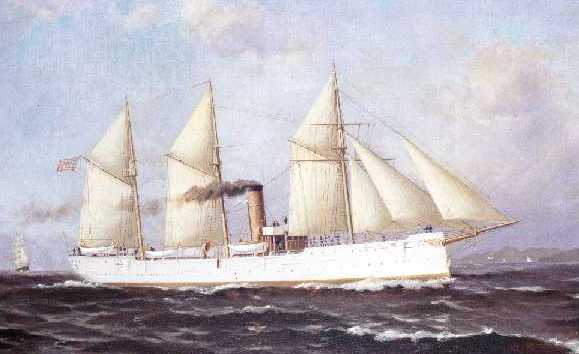 htly edited transcription of the original found in a compilation of Spanish American War reports published by the federal government in 1898.]
htly edited transcription of the original found in a compilation of Spanish American War reports published by the federal government in 1898.]
Late on the afternoon of April 8, 1898, the date of the arrival of this vessel at New Harbor, Singapore, the following cablegram, signed “W.B. Howell, Assistant Secretary,” was transmitted to the commanding officer by the United States consul-general: “Direct commanding officer of the U. S. S. McCulloch on arrival proceed to Hongkong, report his command, duty Commodore Dewey, Asiatic Station.”
The work of coaling and other ship’s business were expedited as much as possible but owing to the general observance on shore of the holiday season accompanying Easter Sunday (April 10), affairs were considerably delayed. On the 11th a second communication was received through our consul-general, as follows: “Send word to consul at Singapore to direct commanding officer of revenue cutter McCulloch, on her arrival there, to proceed quick to Hongkong and to avoid Spanish ports and men-of-war.”
This he indorsed as being an exact copy of message from Department of State, dated April 2, 1898, as communicated to me in dispatch from Hon. John Banes, United States minister at Bangkok, dated April 4, 1898, and received by me on the date below. (Signed) “E. Spencer Pratt, United States Consul General, Singapore, April 11, 1898.”
On the following day, at 11:40, the McCulloch weighed anchor and sailed for Hongkong, experiencing a fair passage, and reaching that port at 3:10 p.m. Sunday, April 17, having logged on the run 1,452 knots [nautical miles]. The American Asiatic Squadron was found to be moored in the man-of-war anchorage, where we were also assigned a berth by the harbor authorities, and the commanding officer, Capt. D.B. Hodgson (U.S. Revenue Cutter Service), at once called upon Commodore George Dewey (U.S. Navy), commander in chief, and reported this command for duty, as per instructions in cablegram previously quoted. The vessel at once went under naval regime, was in the course of the next two days coaled and painted “war” color—a leaden gray—and received from the flagship copies of the naval signal books, sets of signal flags and night signals, copies of all existing squadron orders, and instructions regarding the cipher code and its key. A signal yard was rigged on the foremast, and Lieut. John Mel assigned as signal officer. Later this officer, through his own labors, installed an Ardois system on board, the equal of any in the fleet.
Two of the new pattern Navy three-inch B.L.R.s, [breech-loading rifles] mounted on field carriages, were received, one each from the U.S.S. Baltimore and Raleigh, together with appurtenances and a supply of ammunition, and mounted one on each side of the topgallant forecastle, abreast the forward hatch. They were secured by a wire strap passed through an eyebolt in the deck and then around the axle of the carriage, the best scheme which could be devised in the absence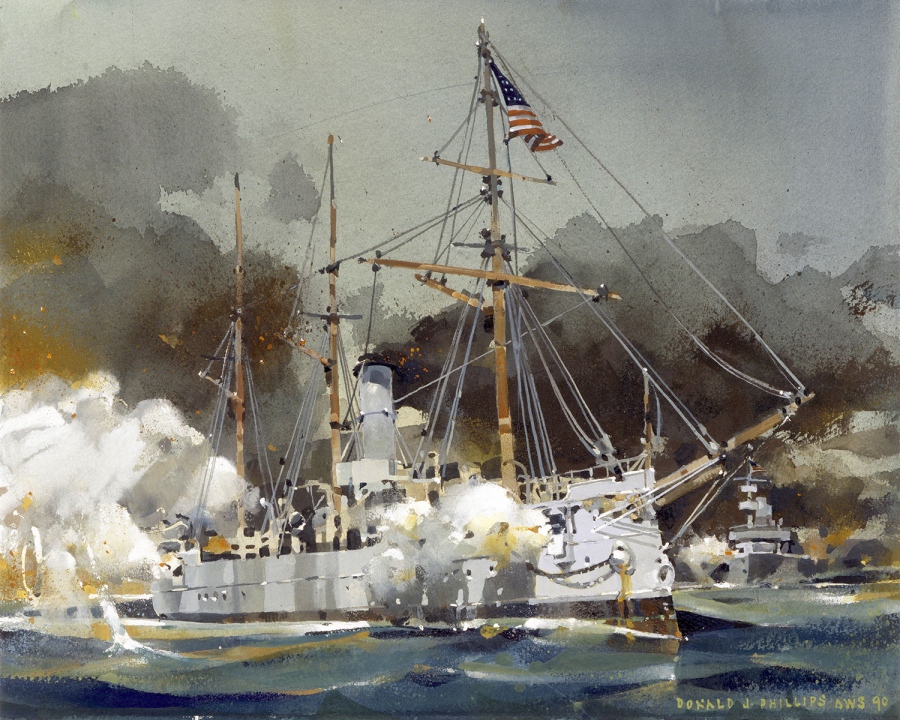 of a proper ship’s mount for them. It may be added here that these pieces were never fired to test the efficiency of the manner in which they were mounted, but were, after the arrival of our troops at Manila Bay, transferred to the Army.
of a proper ship’s mount for them. It may be added here that these pieces were never fired to test the efficiency of the manner in which they were mounted, but were, after the arrival of our troops at Manila Bay, transferred to the Army.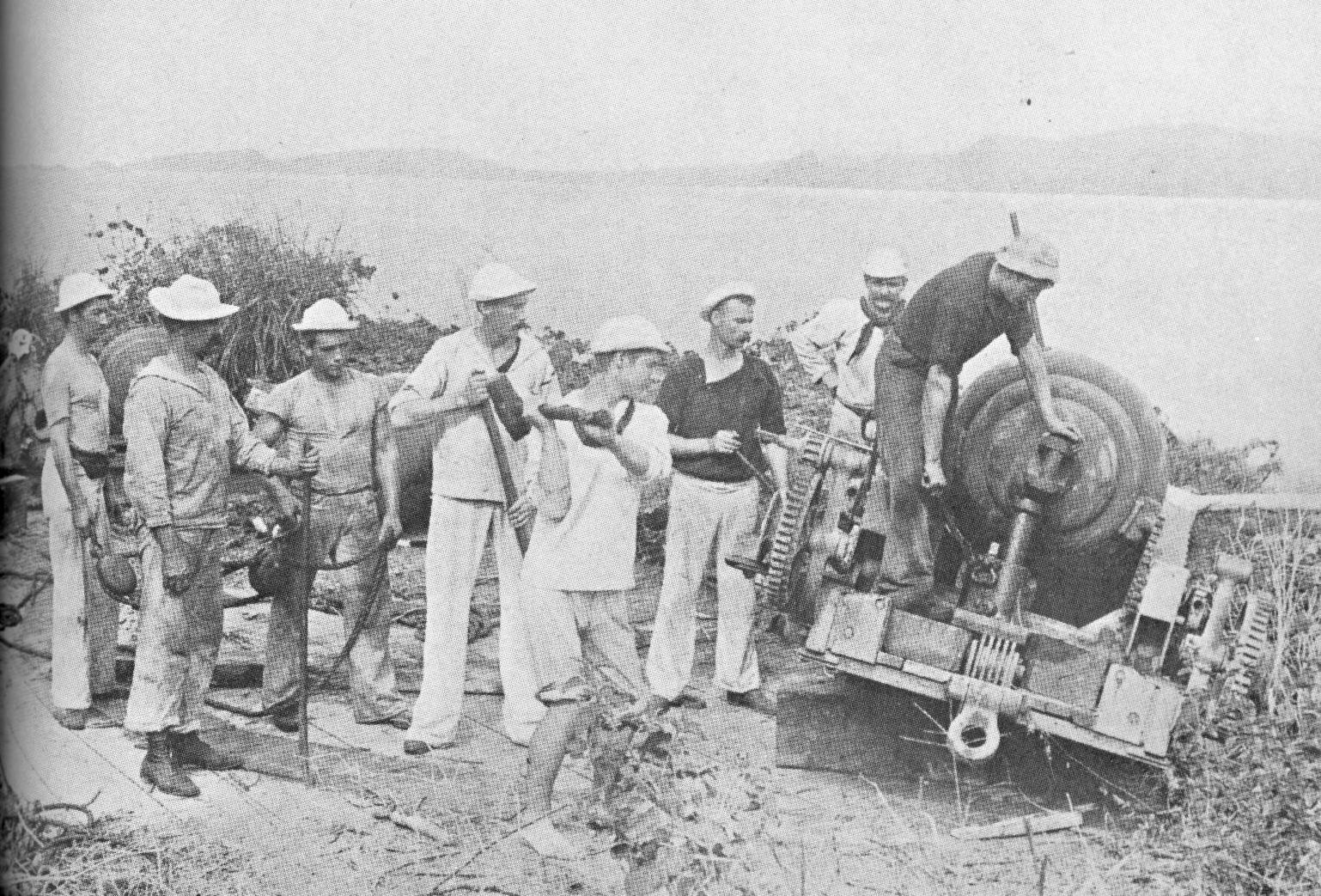
On April 24, the McCulloch sailed for Mirs Bay, China, in company with the warships Boston, Concord, and Petrel, and the storeships Nanshan and Zafiro, the Olympia, Baltimore, and Raleigh following the next day. Here further preparations were made to promote the efficiency and secure the safety of the vessel. The square sail yard was sent down, jib boom rigged in and dismantled, strong backs, awning stanchions, topgallant forecastle rail, gangways, and lower booms unstripped, and with their gear all sent aboard the Nanshan for safekeeping.
At 2 p.m., on April 27, the entire fleet weighed anchor and proceeded to sea on a [southeast] course, steaming in two columns at a standard speed of eight knots per hour, the reserve squadron, headed by the McCulloch, being on the right. That afternoon, in compliance with a signal from the flagship, the remarkable proclamation of the Governor-General of the Philippines was read to the crew at muster, and by them received with three cheers. During the passage toward Manila, the men were exercised at drill, and on the 30th of April final preparations for battle were made; backstays snaked down, boats covered with canvas for splinter shields, barricades made around pilothouse and topgallant forecastle with spare sails, awnings, and hammocks, gaffs slung with chains, after guns protected by piling up in their wake wardroom and cabin bedding, chronometers and standard compasses stored below, anchors secured, clips for rifles all filled, ammunition for the batteries gotten on deck, and magazines c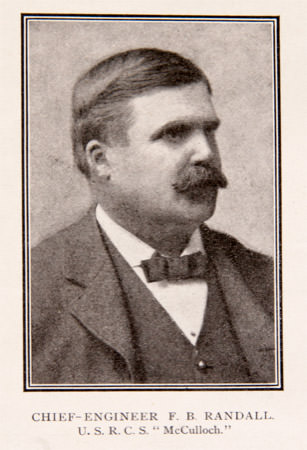 arefully examined for storage. The carpenter also made a number of [wooden] plugs for shot holes, as well as two stretchers for use of the surgeon.
arefully examined for storage. The carpenter also made a number of [wooden] plugs for shot holes, as well as two stretchers for use of the surgeon.
At 4:10 that afternoon, a boat from the McCulloch boarded a native schooner, the San Rafael, with a view of obtaining information regarding the disposition of the Spanish forces, but the visit was of barren results.
At 5:30 the fleet stopped off Subic Bay, and all commanding officers repaired on board the flagship, upon signal for a consultation and to receive orders.
At 6:20 started ahead at a six-knot speed, this vessel having assumed a position astern of the U.S.S. Boston, the formation of the fleet being in indented column, and all lights extinguished except a screened stern light on each vessel. As the evening wore on, the night developed into a partially cloudy one, yet fairly good for seeing, and the long line of vessels, with only an occasional roll of smoke from some stack, with all hands at quarters and in perfect silence, steamed slowly, along the coast toward the entrance of Manila Bay. Entering by the Boca Grande, or southern channel, the indented formation was broken, the Olympia taking the lead, and the rest of the squadron following in single column, this vessel, the Nanshan, and Zafiro, in order named, being the last three.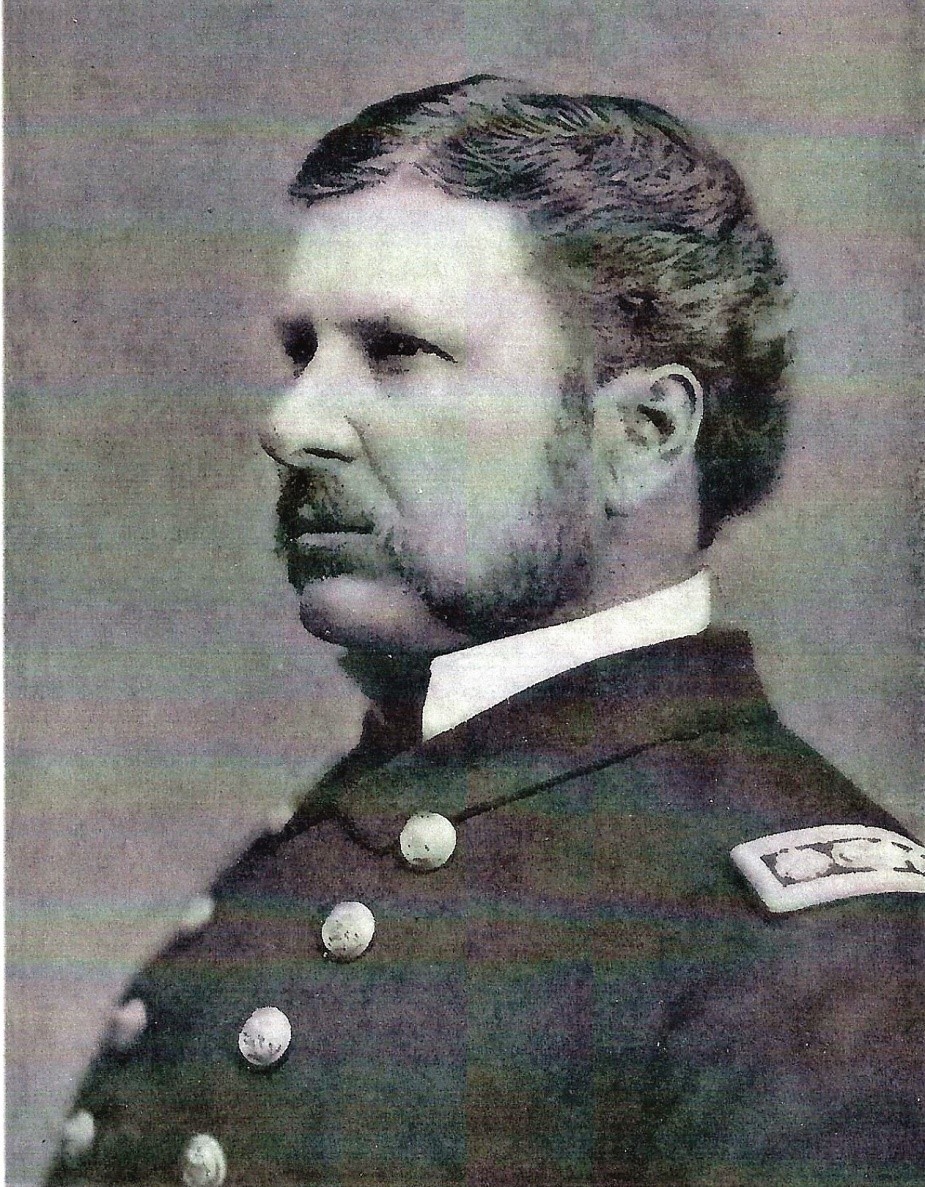
At midnight, the van of the column rounded Corregidor Island and headed up the bay without any sign being made from shore of the presence of an enemy, but at 12:15 a.m., May 1, just as this ship brought El Fraile Rock abaft the starboard beam, the smokestack caught on fire and sent up a pillar of flame like a signal light. Whether or not this was the first seen of our fleet by the Spanish gunners is not known, but it is certain that immediately thereafter a shot was heard from a battery, later discovered to have been on El Fraile Rock, followed quickly by a second one, which passed whistling and tumbling over this vessel. The Boston, just ahead of the McColloch, answered with a six-inch gun, and the McColloch fired three projectiles from [its] after starboard six-pounder R.F. [rapid fire] gun at a range of 4,500 yards. A third shot came from the enemy’s battery and was replied to by an eight-inch shell from the Boston, after which firing ceased.
At a four-knot speed, the fleet now steamed to northward and eastward up the bay, so as to reach its head by daylight. The disposition of the naval vessels of our force in the action which followed off Cavite Sunday, May 1, is well known to all. To this vessel was assigned the duty of protecting the storeships Nanshan and Zafiro from the incursions of any of the enemy’s gunboats, and [McCulloch] was also charged to be ready to assist in towing or otherwise any one of our own fleet which might be disabled. [The McCulloch’s] position was well in advance of the storeships, which lay more toward the center of the bay and close in rear of our line of battle. Shells frequently struck around or passed over the McCulloch, and it is to be questioned, from the wildfire of the Spaniards, if the ship was not in as much danger in the position [it] occupied as if [it] had been in the actual fighting line. When the fleet withdrew from the action, and prior to its resumption, this ship, at about 10:30, was ordered to intercept an approaching merchant vessel, which proved to be the British steamer Esmeralda from Hongkong and warn [it] to anchor till the battle was over. This was carried out, and later during the second portion of the engagement the McCulloch resumed [its] original position in rear of the attacking vessels.
After the surrender of the enemy at Cavi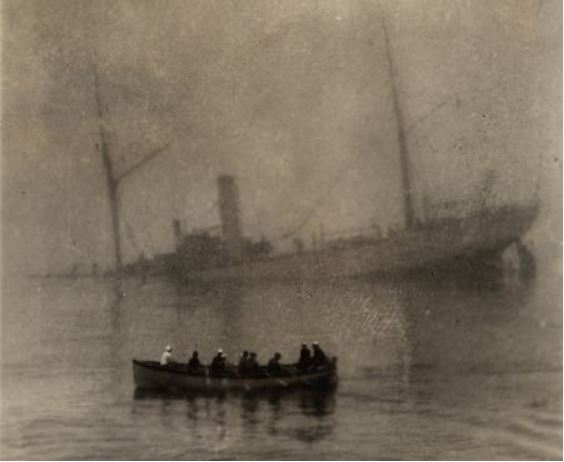 te, the McCulloch proceeded with the major portion of the fleet to an anchorage nearer Manila, and at 2 p.m. conveyed the American consul from the flagship to the British ship Buccleugh with a view of sending dispatches ashore through the agency of [its] captain. At 4 p.m., [it] steamed down the bay with Chaplain Frasier, of the Olympia, board, and at 4:20 p.m. committed to the deep, with naval ceremonies, the body of [McCulloch’s] late chief engineer, F.B. Randall, who, being stricken with an attack of heat apoplexy while in engine room on duty at about 12:30 a.m., had expired at 2:05 a.m. Returned to anchorage at 5, and at 6:15, in response to orders from flagship, moved to a position one-half mile off mouth of Pasig River, with the object of preventing any vessel, war or otherwise, from leaving Manila.
te, the McCulloch proceeded with the major portion of the fleet to an anchorage nearer Manila, and at 2 p.m. conveyed the American consul from the flagship to the British ship Buccleugh with a view of sending dispatches ashore through the agency of [its] captain. At 4 p.m., [it] steamed down the bay with Chaplain Frasier, of the Olympia, board, and at 4:20 p.m. committed to the deep, with naval ceremonies, the body of [McCulloch’s] late chief engineer, F.B. Randall, who, being stricken with an attack of heat apoplexy while in engine room on duty at about 12:30 a.m., had expired at 2:05 a.m. Returned to anchorage at 5, and at 6:15, in response to orders from flagship, moved to a position one-half mile off mouth of Pasig River, with the object of preventing any vessel, war or otherwise, from leaving Manila.
Remained there throughout the night with armed sentinels on watch and battery cast loose. On May 4, the McCulloch coaled from steamship Nanshan.
On the morning of May 5, a signal was received from the Olympia: “Be ready to get underway at 1 p.m.” It was soon ascertained that we were to proceed to Hongkong with dispatches, the cable from Manila to that port having been picked up and cut by order of the commander in chief, upon refusal of the telegraph company’s officials on shore to send forward his messages. During the forenoon there were received board for passage [Lt. Cmdr.] J.B. Briggs (U.S.N.), invalided from U.S.S. Baltimore to naval hospital, Yokohama; Surgeon Kindleberger (U.S.N.), detached from Olympia and ordered home; Pay Inspector D.A. Smith and [Lt.] Brumby, of the Olympia, together with Mr. Stickney, correspondent of the New York Herald, and the commodore’s steward. At 1 p.m., hove up anchor and stood down the bay accompanied by U.S. steamers Boston and Concord. When the Boca Chica Channel was opened a large man-of-war was sighted in the offing, and the captain of the Boston, the senior officer present, gave the signal: “Clear ship for action,” which order was immediately complied with.
Approaching the stranger, [it] proved to be the French cruiser Bruix, and the batteries were thereupon secured. At 3:55, off entrance to the bay, the Boston signaled: “Proceed on your cruise,” whereupon the vessel was put on a course for Hongkong, and the engines started full speed ahead. The voyage was uneventful and the weather very fine and quiet, but warm, the run of 646 knots [nautical miles], as logged, being made from anchorage to anchorage in forty-nine hours and ten minutes, several hours of this time, when in company with Boston and Concord, being only under half speed. The vessel lay in the harbor of Hongkong the twenty-four hours allowed by the British neutrality proclamation, being busily engaged taking on stores for various vessels of our fleet, packages for the officers, and mail matter. Meantime, [Lt.] Brumby, the commodore’s flag lieutenant, had been landed immediately on arrival, and cabled home the first authoritative news of the victory at the battle of Cavite [Manila Bay], May 1.